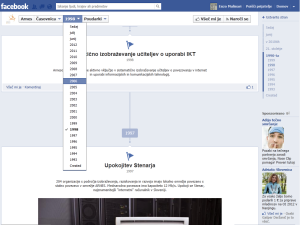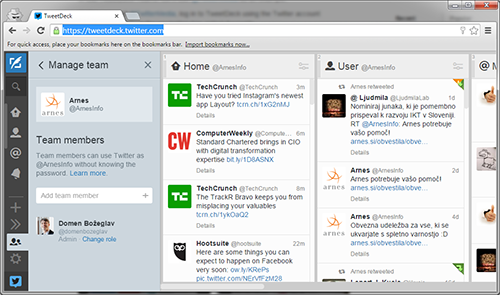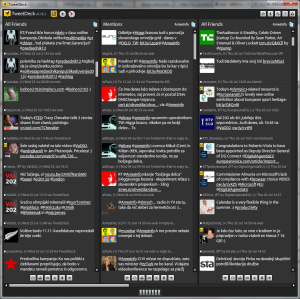...
For details and live examples check the NREN Social Media presence'use cases' wiki page, where you can explore how NRENs have set their Social Media presence. It's best if you start with one Social Media application and once adopted move to others.
If you can't decide on which Social Media to adopt, additional hints can be found at:
- Market analysis of social network platforms and their developments: the list hasn't been updated for a while but it still serves as a reference or pointer to more up-to-date information
- Social networking sites and our lives: which Social Media we usePew Research Center's study on how people's trust, personal relationships, and civic and political involvement are connected to their use of social networking sites and other technologies.
- Social Media Examiner: use cases of various Social Media application uses
...
But if you need a more elaborate Social Media policy, the Social Media policy examples Wiki page offers you a few NREN and a lot of corporate extensive examples, or check out Forresters "The CIO's Guide To Establishing A Social Media Policy". Guidelines on the Ethical Use of Social Media are also a good start for creating your own policy.
5. Start deploying your Social Media
...
- Learn from others. Be active and see for yourself what's working and what's not. Check the NREN Social Media presence Wiki page for ideas.
- You won't be able to monitor the entire Social Media space. Plan deploying various tools such as netvibes to save you time once your applications are in production.
- Technology and applications are changing all the time. Instead of training employees for specific applications, think in more general terms and give them "How to communicate on Social Media" training that will still be of value even when you are migrating from e.g. Facebook to Pinterest.
- If you have very limited resources, you won't likely have a chance to be innovative with your Social Media usage. Learn from others if the knowledge is available - e.g. Do's and Don'ts of Social Media.
- Don't forget to include your NREN Security policy issues while deploying your Social Media. Check out a list of hints. and 5 Social Media security hints video.
Facebook has the highest number of users so it's probably the best "usual suspect" to start with.
- Create your company page profile (don’t use groups since they will be depreciated and don’t create a personal profile for your company since it’s against the FB rules).
- Add company data, try to “talk to people” don’t just use facts.
- Use the new layout mode with a cover photo. We are visual beings and also Social Media is a very visual medium. Check article on Visual elements of FB page and , FB sizes and dimensions cheat sheet and offical FB dimensions guide to achieve perfect visualization of your profile.
- Publish as many photos as you can - people will most likely check them out and engage through them.
- Use the new Timeline feature and create your NREN history.
- Notify your colleagues about the new page and hopefully they will like it (and others will follow them).
...
- Once you create your corporate profile do take time to customise it. It will make all the difference if someone lands on your profile.
- Make sure you state who stands behind the company Twitter profile - name the person(s), so users know who they are talking to.
- Twitter users produce a lot of post so make sure you install the desktop or mobile toolsuse tools like Tweetdeck: https://tweetdeck.twitter.com/. They will help you navigate through the information noise and manage multiple accounts and hash-tags. There are many solutions though for Windows and iOS desktops - we suggest Tweetdeck, and for Android "Tweetdeck" or "Twitter" application.The most important feature with Tweetdeck you should use is "Teams" feature, where you can assign editorial or administrator roles to other twitter users without disclosing your account username and password. More info: https://blog.twitter.com/2015/introducing-tweetdeck-teams?utm_campaign=OT_PU_CON_TweetDeck_US_Teams&utm_medium=email&utm_source=Eloqua Make sure the future editor is logged into Twittdeck before he clicks (confirms) his role through email.
- Don't forget to set automatic notifications for various events - for instance when somebody mentions you or re-posts one of your tweets.
- Since tweeting is so dynamic, make sure you stay connected to emerging trends on Twitter: Twitip.Twitter: Twitip.
- Make sure to use the new profile options for images: http://mashable.com/2014/04/08/twitters-new-profiles-what-you-need-to-know/
LinkedIn could also be called the Facebook for professionals. Especially professionals from technical fields are present and try to "connect" on LinkedIn. A vast number of NREN employees are already present on LinkedIn though the activity rarely exceeds linking with others. A company LinkedIn profile is also good for raising brand awareness.
...
- Understand what you are doing. All Social Media applications have their own rules and you have to understand them to use them effectively.
- Invite your work colleagues and technicians to participate in your Social Media channels. If necessary, provide internal or external Social Media training.
- Make it clear that everyone in the company should be aware of and follow your Social Media guidelines and policy.
- Identify Social Media enthusiasts inside your NREN and actively encourage them.
- Answer questions as soon as possible to maintain you credibility.
- Think about content in advance. Execute your plan with the help of Social Media Conversation Calendar.
- Time your posting for maximum impact. Check out The best and worst time to post info-graphic.
- Always make people feel that their opinion matters.
- And most important: If you have nothing to say, don’t say it!
- Use natural language, so you reduce the distance between you and users.
- Don't try to moderate Social Media. You should rather guide the debate, check out Guidelines on how to react to Social Media posts.
- Don't forget checking the trends all the time. You could be wasting your precious time on Social Media applications that are "so last year"!
...
Deploying and using Social Media is often quite rewarding since it's very easy to measure the impact of your efforts. Each Social Media application usually has it's own insights tool (check out the new Facebook insights features available from September 2013) which will show you when and how users react to your posts. These insights are very useful so make sure you check them frequently and even more important, act on them accordingly.
...
- Provide your user support via Social Media (some NRENs already do that). Check out, how you can use a community to even reduce your user support efforts. .
- If you work with schools, check out European Schoolnet's SMILE - Social Media in Learning and Education handbook.
- Make tighter connections with your service leaders and help them make their own Social Media promotions by themselves.
- Contribute your findings to TF-CPR so we can make this Jumpstart Pack even more usable and keep it up to date.
- If you like to stay up to date, check these Social Media portals for what's new:



